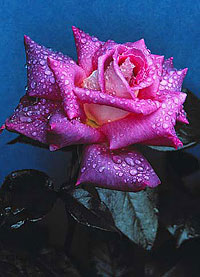 |
'MANpurple',
Hybrid Tea 'MANpurple' is the "Grandfather" of all my Miniature Roses |
| Name: | ‘MANpurple’ , Mander 1991 |
| Type: | Hybrid Tea, m |
| Parentage: | Mount Shasta (Gr) x Super Sun (HT - a sport of Picadilly) |
| Introduced: | Was never introduced. Used it for breeding only. |
| Blooms: | Purple/cream bicolor, very attractive color, 20 petals, dia. 12.5 cm, eye catching, decorative form. |
| Fragrance: | Slight |
| Foliage: | Medium, dark green and glossy |
| Disease Resistance: | Very good. It never had mildew nor blackspot in its 27 years of existence. I only spray fungicide once a month from April to September. |
| Winter Hardiness: | Average, to zone 5. |
| Plant Size: | Up to 150 cm tall, (5 feet) |
| Flowering Period: | Blooms continuously until the first frost. |
| Additional Notes: | This rose was "born" in 1974. |
'MANpurple' (registered codename) laid the groundwork for things to come. It is a beautiful purple/cream bicolor and I have never ever seen any mildew (even without spraying for 10 weeks) on my plants for over 25 years now. There is a beautiful photograph of 'MANpurple' in the October 1997 American Rose on page 27, plus there is a photo of it in my HT Gallery.
The bicolor, I am sure, came from 'Piccadilly' through its sport 'SUPER SUN'. Since the seed parent was white, it was a puzzle where the purple came from. I tried to trace back both parents, but I soon came to a dead end and did not find any purple ancestors anywhere. So it must have been a fluke, a chance in a million.
Since I was seeking to introduce the color realized in 'MANpurple' into my future hybrids, I used its parents repeatedly for several years trying to come up with a non fading purple/cream. I soon gave up on this idea however, as I had no luck. All I was getting from hundreds of seedlings was pink, red and white colors and not a single one of mauve or purple, nor any bicolor. I could only wonder if the purple bicolor of 'MANpurple' would ever repeat in my new seedlings.
Changing direction, I began crossing 'MANpurple' with other cultivars. First as a seed parent, only a few seeds were produced over several years and not a single one ever germinated. Then, when used as a pollen parent I have tried it on every H.T. and Fl. I had. Again, very few seeds were produced, fewer still germinated and all I got was red or pink seedlings. The years went by and it was already 1987/88 when I gave up on big roses.
I never gave up completely though, and changed directions once again. In 1988 I had my first miniature rose, which I subsequently budded to a tree rose. It was 'Rise 'n' Shine' and I knew it had been used extensively by many breeders. In 1989 I counted 105 blooms on this tree rose and I decided that I might as well pollinate as many as possible with 'MANpurple'. Maybe, just maybe, I thought, the purple/cream bicolor will finally come through? My efforts produced about 75 hips with more than 600 seeds from which about 100 germinated. Half of the blooms were just white while others revealed colors of yellow, scarlet, red, pink and some bicolors as well. But finally, at long last: a few came up with the purple/cream bicolor blooms that I had been seeking for 15 years.
All in all, I had a total of only five seedlings with this most elusive color. Two were floribundas and three were miniatures and only one of the minis turned out to be non-fading. It was also very mildew resistant and the most vigorous seedling I had ever produced. Thinking it a gem, I registered this rose in April 1992 as 'Rubies 'n' Pearls'. And so my "Canadian Gem Series and Rainbow Collection of Roses" was born.
MANpurple was never introduced as it opens too fast and fades rapidly and I only used it for breeding. There is a photo of Manpurple in my Hybrid Tea Gallery.
George Mander
January 2003